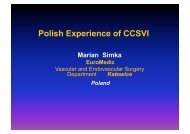ISNVD Abstract Book
ISNVD Abstract Book
ISNVD Abstract Book
Create successful ePaper yourself
Turn your PDF publications into a flip-book with our unique Google optimized e-Paper software.
useful in assessing blood products such as microbleeds and hemorrhagespossibly due to traumatic<br />
braininjury,vasculardementia,orMS.SWIMRAcanrevealarteriesandveinsontheorderofafew<br />
hundredmicronsbymeansofadualechosequence.MRAandMRVdatacanbeobtainedatthesame<br />
time.<br />
<br />
Formoreconventionalimaging,T2WIisusedtoshowtissuewithlongT2componentssuchasedema,<br />
CSF,tumors,andMSlesions.3DT2FLAIRisusedbecausetheimageshavesuppressedCSFsignal.FLAIR<br />
showsperiventricularlesionswellwithouttheinterferencefromCSF.Lesionquantityandvolumecan<br />
lsobeassessedwithFLAIR.Eventuallyitmaybepossibletocomparelesionvolumewithbloodflowor<br />
patient’sphysiologicalchangesovertime.T1WIisusedattwopartsofthescanningprotocoltoimage<br />
the head: initially before contrast agent injection, and after contrast agent injection.Lesions that<br />
enhancepostcontrastareconsideredasacute.<br />
<br />
PWIisusedtoevaluatethehemodynamicsofthebrain.Fromthisdataitispossibletoassessmean<br />
transittime(MTT)whichisthetimeittakesforcontrastagenttopassthroughthemicrovasculature;the<br />
cerebralbloodvolume(CBV)andthecerebralbloodflow(CBF).<br />
<br />
Notallthesescansneedtoberunoneverypatient.Thefullprotocolbelowisusedinaresearchmode.<br />
Whilethefullprotocolscantakesroughly1hour,22minutestorun,thereareshorterprotocolswith<br />
andwithoutcontrastthatcanreducethescantime.Removingthecontrastdependentsequencescan<br />
reducethetotalscantimetoapproximately52minutes.Foraposttreatmentscanwithoutcontrastand<br />
azygousdata,thescantimewouldbereducedtoapproximately34minutes:lesions,ironcontent,<br />
anatomyfrom2DTOFMRV,andbloodflowwouldstillbeabletobeassessed.<br />
<br />
ScanningProcedure<br />
<br />
Initially,registerthepatientalongwithhis/herheightandweight.Thisplaysanimportantrolein<br />
flowquantification(FQ).<br />
Activateappropriate(head,neckandspine)coilsforimagingtheregionofinterest.<br />
Makesuretoputthepulsetriggeronthesubject's(left/right)indexfingerorforabetterflow<br />
quantificationcardiacgatingcanbeused.<br />
Initially,westartimagingtheheadusingSWI,T2,MPRAGE,FLAIR,VIBE,andPWIsequences.<br />
Make sure to use the head and neck coils. Inject 5cc of contrast agent on the 10 th <br />
measurementofPWIsequence.<br />
Later, move the table to center at the neck and acquire T2, 3D CE MRAV, and flow<br />
quantification (FQ) sequences. Make sure to use the head neck coils. Inject the remaining<br />
contrastagentonthe3 rd measurementof3DCEMRAV.<br />
The FQ plane will be set perpendicular to the CSF flow at C2/C3 necklevel with a VENC of<br />
10cm/sec,andsetperpendiculartotheinternaljugularveins(IJV’s)attheC2/C3,C5/C6and<br />
C7/T1necklevelswithavencof50cm/sec.<br />
Next,movethetablecenterbacktotheheadandacquirethedatausingthepostgadolinium<br />
sequencesVIBE,andMPRAGE.<br />
Toimagetheazygous,movethetabletocenteratthemidsternum.Usetheneckandspine<br />
coils.Acquire2DTOFMRVandFQsequences.UseaVENCof50cm/secfortheFQsequence.




